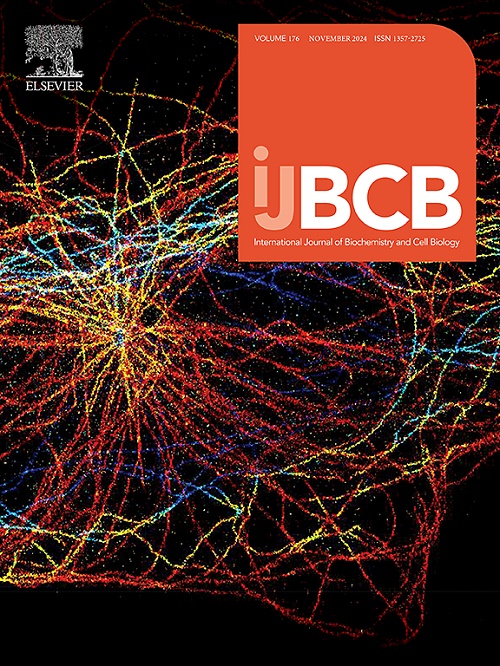PBX1过表达通过转录抑制TXNIP减轻糖尿病心肌病的氧化应激和细胞凋亡。
IF 2.8
3区 生物学
Q2 BIOCHEMISTRY & MOLECULAR BIOLOGY
International Journal of Biochemistry & Cell Biology
Pub Date : 2025-07-03
DOI:10.1016/j.biocel.2025.106828
引用次数: 0
摘要
糖尿病性心肌病(DCM)是糖尿病患者特有的心血管疾病。DCM的病理生理受到氧化应激和细胞凋亡的显著影响,这是该疾病的关键机制。PBX同源盒1 (PBX homeobox 1, PBX1)是一种同源域转录因子,在调控多种生物过程中起着至关重要的作用。然而,PBX1在DCM中的确切分子机制尚不清楚。在本研究中,我们研究了PBX1对心脏损伤的保护作用。采用雄性C57BL/6小鼠注射链脲佐菌素模拟体内DCM。利用腺相关病毒载体介导的PBX1基因操作在小鼠中过表达PBX1。结果表明,PBX1在DCM小鼠左心室组织中表达显著下调,PBX1过表达可减轻心肌纤维化,增强心功能。此外,我们的研究结果表明,PBX1过表达可有效降低dcm影响小鼠的氧化应激和细胞凋亡。为了模拟体外DCM,我们用高糖(HG)处理人心肌细胞AC16细胞,体外实验结果与体内实验结果一致。机制上,PBX1可结合硫氧还蛋白相互作用蛋白(TXNIP)启动子区,并对TXNIP的转录产生负调控作用。总之,这些结果表明,PBX1的过表达通过转录抑制TXNIP的表达来减轻DCM进展中的氧化应激和凋亡。PBX1可能是一种新的治疗DCM的候选药物。本文章由计算机程序翻译,如有差异,请以英文原文为准。
Overexpression of PBX1 attenuates oxidative stress and apoptosis in diabetic cardiomyopathy by transcriptionally inhibiting TXNIP
Diabetic cardiomyopathy (DCM) is a cardiovascular disease specific to patients with diabetes. The pathophysiology of DCM is significantly influenced by oxidative stress and apoptosis, which are critical mechanisms underlying the disease. PBX homeobox 1 (PBX1) is a homeodomain transcription factor, which plays a crucial role in regulating various biological processes. However, the precise molecular mechanism of PBX1 in DCM is still unclear. In this study, we investigated the protective effect of PBX1 against cardiac injury. Male C57BL/6 mice subjected to streptozotocin were used to simulate DCM in vivo. Genetic manipulation of PBX1 mediated by the adeno-associated virus-based vectors was employed to overexpress PBX1 in mice. The findings indicated that PBX1 expression was significantly downregulated in the left ventricular tissues of DCM mice, and overexpression of PBX1 mitigated cardiac fibrosis and enhanced cardiac function. Additionally, our results demonstrated that PBX1 overexpression effectively reduced oxidative stress and apoptosis in DCM-affected mice. To mimic DCM in vitro, human cardiomyocytes AC16 cells were treated with high glucose (HG), and results obtained in vitro were consistent with those in vivo. Mechanistically, PBX1 could bind to the promoter region of thioredoxin interacting protein (TXNIP) and exerted a negative regulatory effect on TXNIP transcription. In conclusion, these results suggest that overexpression of PBX1 attenuates oxidative stress and apoptosis in DCM progression by transcriptionally inhibiting TXNIP expression. PBX1 may be a novel therapeutic candidate for DCM treatment.
求助全文
通过发布文献求助,成功后即可免费获取论文全文。
去求助
来源期刊
CiteScore
8.10
自引率
0.00%
发文量
124
审稿时长
19 days
期刊介绍:
IJBCB publishes original research articles, invited reviews and in-focus articles in all areas of cell and molecular biology and biomedical research.
Topics of interest include, but are not limited to:
-Mechanistic studies of cells, cell organelles, sub-cellular molecular pathways and metabolism
-Novel insights into disease pathogenesis
-Nanotechnology with implication to biological and medical processes
-Genomics and bioinformatics

 求助内容:
求助内容: 应助结果提醒方式:
应助结果提醒方式:


